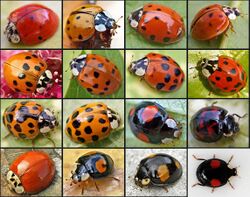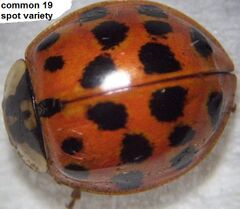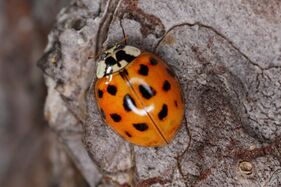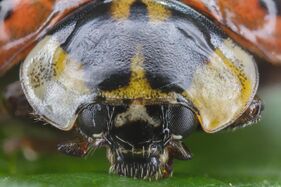Biology:Harmonia axyridis
| Harmonia axyridis | |
|---|---|

| |
| Scientific classification | |
| Domain: | Eukaryota |
| Kingdom: | Animalia |
| Phylum: | Arthropoda |
| Class: | Insecta |
| Order: | Coleoptera |
| Infraorder: | Cucujiformia |
| Family: | Coccinellidae |
| Genus: | Harmonia |
| Species: | H. axyridis
|
| Binomial name | |
| Harmonia axyridis (Pallas, 1773)
| |
| Synonyms | |
| |
Harmonia axyridis is a large lady beetle or ladybug species that is most commonly known as the harlequin, Asian, or multicoloured asian lady beetle. This is one of the most variable species in the world, with an exceptionally wide range of colour forms.[1] It is native to eastern Asia, but has been artificially introduced to North America and Europe to control aphids and scale insects. It is now common, well known, and spreading in those regions, and has also established in Africa and widely across South America. This species is conspicuous in North America, where it may locally be known as the Halloween beetle, as it often invades homes during October to overwinter.[2]
When the species first arrived in the UK, it was labelled in jest as the "many-named ladybird" due to the great quantity of vernacular names. Among those already listed other names include multivariate, southern, Japanese, and pumpkin ladybird.[3]
Description
Harmonia axyridis is a typical coccinellid beetle in shape and structure, being domed and having a "smooth" transition between its elytra (wing coverings), pronotum, and head. It ranges from 5.5–8.5mm in size. The common color form, f. "succinea", is orange or red in colouration with 0–22 black spots of variable size. The other usual forms, f. "conspicua" and f. "spectabilis", are uniformly black with, respectively, two or four red markings. The pronotum is white with variable black patterning, ranging from a few black spots in an M formation to almost entirely black. The underside is dark with a wide reddish-brown border.
However, numerous other forms have also been recorded. Extreme forms may be entirely black, or feature complex patterns of black, orange and red.
The large size of this species is usually the first clue to its identification.[4][5] Despite variation, this species does not generally overlap in pronotal or elytral pattern with any other species, except in unmarked orange or red forms. In Europe it is similar to the much smaller Adalia decempunctata, while in America it is similar to the much smaller Mulsantina picta and spotless forms of Adalia bipunctata. When identification is difficult, the underside pattern usually enables a reliable conclusion.[1] Identification is most simple for the common forms, while less common varieties may take longer to identify.[6] They always have reddish-brown legs and are obviously brown on the underside of the abdomen, even in the melanic colour forms.
Range
Harmonia axyridis is native to eastern Asia from central Siberia, Kazakhstan, and Uzbekistan in the west, through Russia south to the Himalayas and east to the Pacific coast and Japan , including Korea, Mongolia, China , and Taiwan. As a voracious predator, it was identified as a biocontrol agent for aphids and scale insects. Consequently, it has been introduced into greenhouses, crop fields, and gardens in many countries, including the United States and parts of Europe. The species is now established in North America (United States, Canada , Mexico), Central America (Guatemala, Honduras, Costa Rica, Panama), South America (Brazil , Venezuela, Colombia, Ecuador, Peru, Argentina , Chile ), Europe (Italy, Spain , the United Kingdom , Denmark , Sweden, Norway , Finland , the Netherlands, Belgium, Luxembourg, France , Germany , the Czech Republic, Slovakia, Hungary, Romania, Serbia, Croatia, Bosnia and Herzegovina, Poland ), Israel, New Zealand, and South Africa .[7]
North America
This species spread across continents because of human-mediated processes. They became established in North America as the result of introductions into the United States in an attempt to control the spread of aphids. In the last three decades, this insect has spread throughout the US and Canada, and has been a prominent factor in controlling aphid populations. The first introductions into the US took place as far back as 1916. The species repeatedly failed to establish in the wild after successfully controlling aphid populations, but an established population of beetles was observed in the wild near New Orleans, Louisiana, in about 1988. In the following years, it quickly spread to other states, being occasionally observed in the Midwest within five to seven years and becoming common in the region by about 2000. The species was also established in the Northwest by 1991, and the Northeast by 1994, aided by additional introductions from the native range, rather than just reaching there from the Southeast. Reportedly, it has heavily fed on soybean aphids (which recently appeared in the US after coming from China ), supposedly saving farmers vast sums of money in 2001.[citation needed]
Worldwide propagation
Worldwide routes of propagation of H. axyridis were described with genetic markers in 2010.[8] The populations in eastern and western North America originated from two independent introductions from the native range.[8] The South American and African populations both originated independently from eastern North America.[8] The European population also originated from eastern North America, but with substantial genetic admixture with individuals of the European biocontrol strain (estimated at 40%).[8]
This species is widely considered to be one of the world's most invasive insects,[9][10] partly due to their tendency to overwinter indoors and the unpleasant odor and stain left by their bodily fluids when frightened or crushed, as well as their tendency to bite humans.[9] In Europe it is currently increasing to the detriment of indigenous species,[9] its voracious appetite enabling it to outcompete and even consume other ladybirds.[9] The harlequin ladybird is also highly resistant to diseases that affect other ladybird species, and carries a microsporidian parasite to which it is immune, but that can infect and kill other species.[10] Native ladybird species have experienced often dramatic declines in abundance in areas invaded by H. axyridis.[11] In 2015, it was declared the fastest invading species in the UK, spreading throughout the country after the first sighting was confirmed in 2004.[12]
In addition to its household pest status,[13] the harlequin has been reported to be a minor agricultural pest that is inadvertently harvested with crops in Iowa, Ohio, New York State, and Ontario.[14] This can cause visible and sensory contamination.[15] Contamination of grapes by this beetle has been found to alter the taste of wine.[16]
Biology and behaviour
Harmonia axyridis becomes dormant in cooler months, though it will move around whenever the temperature reaches about 10 °C (50 °F). Because the beetles will use crevices and other cool, dry, confined spaces to overwinter, significant numbers may congregate inside walls if given a large enough opening.
Large aggregations are often seen in autumn. The beetles have pheromones to signal to each other. However, many aggregation cues are visual, picking out sites at both long (light-coloured structures that are distinct from their surroundings) and short (pre-existing aggregations to join) distances. Non-volatile long-chain hydrocarbons laid down by previous aggregations also play a significant role in site selection. Both visual and hydrocarbon cues are more important than volatile pheromones.
They often congregate in sunlit areas because of the heat available, so even on fairly cold winter days, some of the hibernating beetles will "wake up" because of solar heating. Large populations can be problematic because they can form swarms and linger in an area for a long time. The beetles can form groups that stay in upper corners of windows. This beetle has been also found to be attracted to dark screening material for its warmth. It has good eyesight; it will return from a location to which it is removed, and is known to give a small bite if provoked.[17]
Harmonia axyridis, like other ladybeetles or ladybirds, uses isopropyl methoxy pyrazine as a defensive chemical to deter predation, and also carries this chemical in its hemolymph at much higher concentrations than many other ladybeetle species, along with species-/genus-specific defensive compounds such as harmonine. These insects will "reflex bleed" when agitated, releasing hemolymph from their legs. The liquid has a foul odour (similar to that of dead leaves), a bitter taste, and can stain porous materials. Some people have allergic reactions, including allergic rhinoconjunctivitis when exposed to these beetles.[2] Occasionally, the beetles will bite humans,[2] presumably in an attempt to acquire salt, although many people feel a pricking sensation as a beetle walks across the skin. Bites normally do no more harm than cause irritation, although a small number of people are allergic to bites.[18] Their natural predators include birds, spined soldier bugs, ants (including the also invasive Solenopsis invicta) and other coccinellids, including fellow Harmonia axyridis.[19]
These beetles can be difficult to identify because of their variations in color, spot size, and spot count of the elytra. The easiest way to identify H. axyridis f. succinea is to look at the pronotum and see whether the black markings look like a letter "W" or "M". This species has more white markings on the pronotum than have most native North American species, though this feature is not useful when attempting to separate it from species in other parts of the world.
Mating
Wings spread out
Ready for flight
Control
Numerous methods of control have been investigated in areas where this beetle has been introduced and causes a threat to native species and biodiversity and to the grape industry. Methods of control include insecticides, trapping, removal of aggregates of beetles, and mechanically preventing entry to buildings.[20] Methods under development involve the investigation of natural parasites and pathogens, including the use of parasitic sexually transmitted mites and fungal diseases.[21]
The best methods for dealing with H. axyridis in private homes involve sealing openings they may enter.[22] Sweeping and vacuuming are considered effective methods for removing them from homes, though this should be done carefully so as not to trigger reflex bleeding. A nylon stocking placed inside the vacuum cleaner's hose, secured with a rubber band, allows the beetles to be "bagged" rather than collected inside the machine.[23] A trap designed for indoor use was developed which attracts the beetles with a light and seals them in a removable bag.[22]
Biochemistry
Harmonia axyridis secretes a number of defensive compounds, one of which, (9Z,17R)-9-Octadecene-1,17-diamine (harmonine) has been isolated from its hemolymph. This molecule has been reported to have broad-spectrum antimicrobial activity that includes human pathogens. Antibacterial activity is most pronounced against fast-growing mycobacteria and Mycobacterium tuberculosis, and the growth of both chloroquine-resistant Plasmodium falciparum strains is also inhibited;[24] causative agents of tuberculosis and malaria respectively.
References
- ↑ 1.0 1.1 "Adalia, Field Guide to Ladybugs of North America on the App Store". https://itunes.apple.com/us/app/adalia-field-guide-to-ladybugs/id1121061924?ls=1&mt=8.
- ↑ 2.0 2.1 2.2 R. L. Koch (2003). "The multicolored Asian lady beetle, Harmonia axyridis: A review of its biology, uses in biological control, and non-target impacts". Journal of Insect Science 3: 32. doi:10.1093/jis/3.1.32. PMID 15841248. PMC 524671. http://www.insectscience.org/3.32/Koch_JIS_3_32_2003.pdf.
- ↑ Ladybird Survey page "Harmonia axyridis (Pallas) in Britain" "Harmonia axyridis, the invasive harlequin ladybird (Coccinellidae) establishing in London, Essex and the UK". http://www.ladybird-survey.pwp.blueyonder.co.uk/H_axyridis.htm. Accessed 7 Jan 2008
- ↑ "Harlequin Ladybird Survey - Recognition and Distinction". http://www.harlequin-survey.org/recognition_and_distinction.htm.
- ↑ "Species Harmonia axyridis - Multicolored Asian Lady Beetle - BugGuide.Net". http://bugguide.net/node/view/397.
- ↑ "Harmonia axyridis". College of Agriculture and Life Sciences, Cornell University. http://www.biocontrol.entomology.cornell.edu/predators/Harmonia.html.
- ↑ Cisneros-Heredia, Diego F.; Peñaherrera-Romero, Emilia (2020-11-27). "Invasion history of Harmonia axyridis (Pallas, 1773) (Coleoptera: Coccinellidae) in Ecuador" (in en). PeerJ 8: e10461. doi:10.7717/peerj.10461. PMID 33312773.
- ↑ 8.0 8.1 8.2 8.3 Eric Lombaert; Thomas Guillemaud; Jean-Marie Cornuet; Thibaut Malausa; Benoît Facon; Arnaud Estoup (2010). "Bridgehead Effect in the Worldwide Invasion of the Biocontrol Harlequin Ladybird". PLoS ONE 5 (3): e9743. doi:10.1371/journal.pone.0009743. PMID 20305822. Bibcode: 2010PLoSO...5.9743L.
- ↑ 9.0 9.1 9.2 9.3 "Harlequin Ladybird Survey - Origins". http://www.harlequin-survey.org/factfile/concern.htm.
- ↑ 10.0 10.1 Yong, Ed (2013). "Invasive ladybird has biological weapon". Nature. doi:10.1038/nature.2013.13011. http://www.nature.com/news/invasive-ladybird-has-biological-weapon-1.13011. Retrieved 10 March 2018.
- ↑ Russell F. Mizell III (2007). "Impact of Harmonia axyridis (Coleoptera: Coccinellidea) on native arthropod predators on pecan and crape myrtle" (PDF). Florida Entomologist 90 (3): 524–536. doi:10.1653/0015-4040(2007)90[524:IOHACC2.0.CO;2]. http://journals.fcla.edu/flaent/article/view/75692/73350.
- ↑ Smith, Lewis (20 May 2015). "Harlequin ladybirds declared UK's fastest invading species". https://www.theguardian.com/environment/2015/may/20/harlequin-ladybirds-declared-uks-fastest-invading-species.
- ↑ "Orkin Asian Lady Beetles". 11 April 2018. http://www.orkin.com/other/beetles/ladybugs-asian-lady-beetles/.
- ↑ Betty Summerhayes (July 6, 2007). "OMAFRA Achievements in Crop Technology 2007". Government of Ontario. http://www.omafra.gov.on.ca/english/crops/resource/2007achieve.htm.
- ↑ "Multicolored Asian Lady Beetle". http://ohioline.osu.edu/ent-fact/pdf/0044.pdf.
- ↑ Gary Pickering; James Lin; Roland Riesen; Andrew Reynolds; Ian Brindle; George Soleas (January 2004). "Influence of Harmonia axyridis on the sensory properties of white and red wine". American Journal of Enology and Viticulture 55 (2): 153–159. doi:10.5344/ajev.2004.55.2.153. http://www.ajevonline.org/cgi/content/abstract/55/2/153.
- ↑ "Multicolored Asian Ladybeetle (Harmonia axyridis)". http://www.pestid.msu.edu/InsectsArthropods/MulticoloredAsianLadybeetleHarmoniaaxyridis/tabid/253/Default.aspx.
- ↑ "Medscape". http://www.medscape.com/viewarticle/547512?src=mp.
- ↑ "Harmonia axyridis". https://animaldiversity.org/accounts/Harmonia_axyridis/.
- ↑ Marc Kenis; Helen E. Roy; Renate Zindel; Michael E. N. Majerus (2008). "Current and potential management strategies against H. axyridis". BioControl 53 (1): 235–252. doi:10.1007/s10526-007-9136-7. http://doc.rero.ch/record/8844/files/zindel_cpm.pdf.
- ↑ Helen Elizabeth Roy; Peter M. J. Brown; Peter Rothery; Remy L. Ware; Michael E. N. Majerus (2008). "Interactions between the fungal pathogen Beauveria bassiana and three species of coccinellid: Harmonia axyridis, Coccinella septempunctata and Adalia bipunctata in: From Biological Control to Invasion: the Ladybird Harmonia axyridis as a Model Species". BioControl 53 (1): 265–276. doi:10.1007/s10526-007-9122-0. http://nora.nerc.ac.uk/2453/.
- ↑ 22.0 22.1 "USDA site". Ars.usda.gov. http://www.ars.usda.gov/is/br/lbeetle/#prevention.
- ↑ "Ohio State University Extension Fact Sheet". Ohioline.osu.edu. http://ohioline.osu.edu/factsheet/ENT-44.
- ↑ Christian Rene Röhrich; Che Julius Ngwa; Jochen Wiesner; Henrike Schmidtberg; Thomas Degenkolb; Christian Kollewe; Rainer Fischer; Gabriele Pradel et al. (21 September 2011). "Harmonine, a defence compound from the harlequin ladybird, inhibits mycobacterial growth and demonstrates multi-stage antimalarial activity". Biology Letters 8 (2): 308–311. doi:10.1098/rsbl.2011.0760. PMID 21937493.
External links
- An extensive review of literature on the multicolored Asian lady beetle
- The multi-colored Asian lady beetle FAQ
- Report sightings of the harlequin ladybird in the British Isles
- Report sightings of the harlequin ladybird in the Netherlands
- Multicolored Asian lady beetle, University of Florida / Institute of Food and Agricultural Sciences Featured Creatures
- Swiss agricultural research station Agroscope: Project on Asian lady beetle control
Wikidata ☰ Q499627 entry
 |







